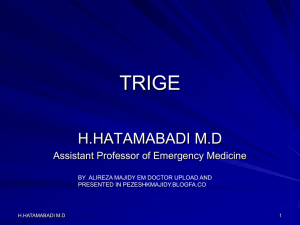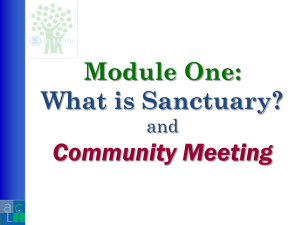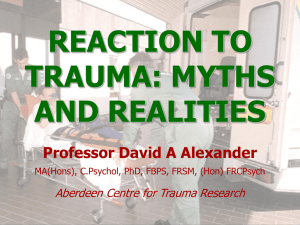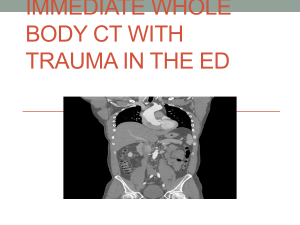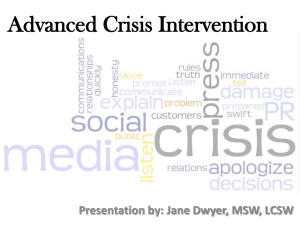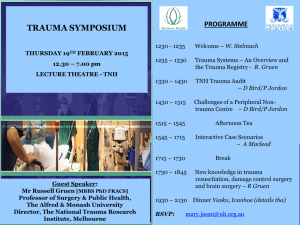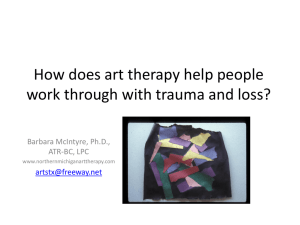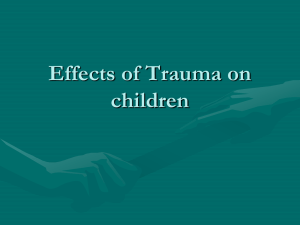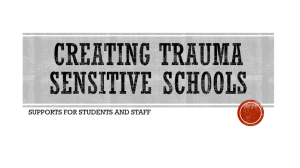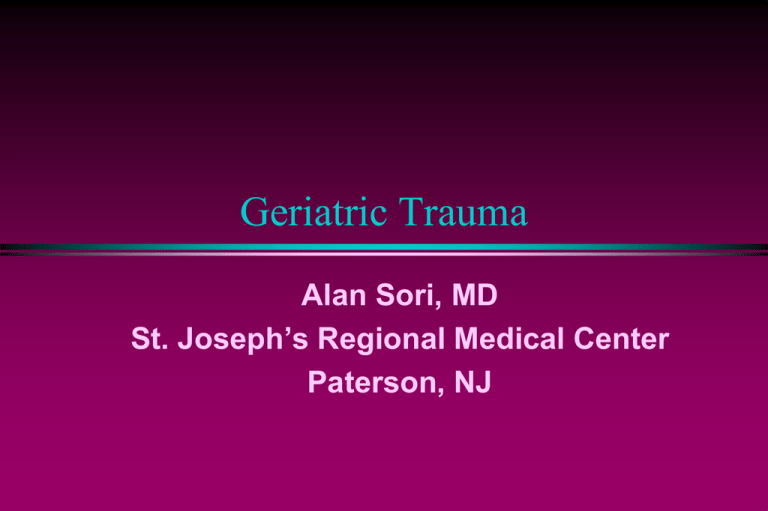
Geriatric Trauma
Alan Sori, MD
St. Joseph’s Regional Medical Center
Paterson, NJ
Patients
65 yo female falls on a bus – severe brain
injury
ICU – found to have a prolonged QT interval
Echo – severe cardiomyopathy
Needs an ICD
In
75 yo male falls- two broken ribs.
Multiple
medical co-morbidities
Develops pneumonia, dies two weeks after injury
What is Geriatric Trauma?
No. 5 cause of death for age > 65.
Mortality in most series averages 15 to 30%.
4
to 5 X mortality of younger patients.
Mortality start to increase at age 45 for males.
ACS
- MTOS
Geriatric Trauma - Questions
What is old?
Does
age matter and what age?
– Physiology of aging.
Triage of elderly trauma victims.
Injury
patterns and physiologic responses.
What is the optimal resuscitation of the older
trauma patient?
Outcomes in the elderly trauma patient?
Geriatric Bias
Documented bias in medical care:
Rehabilitation
placement.
Breast cancer management.
Thrombolytics.
Trauma triage.
“Therapeutic Nihilism”
Epidemiology
Age > 65: 12.5% population (30 million)
2020
- 52 Million (20% population)
At age 85 life expectancy is 5 to 7 years.
– Better health and increased activities.
65+
are hospitalized for trauma at 2X the rate of
younger patients
– 25% of all trauma deaths
beds – 15% of all hospital beds and 30% of
hospital costs
ICU
Epidemiology
>65 use 33% of all health care dollars and
25% of all trauma care money.
Medicare - DRG based- grossly underpays
hospital costs for trauma, esp. in the elderly
Avg.
reimbursement 40 to 65% of total hospital
costs.
– Increased age and ISS - worse reimbursement.
Geriatric Recidivists
Washington state Medicare population.
>
65 injured - 2X more likely to be admitted with a
new injury than uninjured person in next 24
months.
ISS 16 to 24 - new injury risk 4x normal
population.
Inc risk in patients with COPD, liver disease, age.
J. Trauma 1996: 41(6) p. 952
Physiology of Aging
Aging is the progressive loss of individual
organ function.
Gradual
and continuous.
Not directly related to age.
Significant age related mortality differences are
apparent by age 40 in males.
Co-morbidities: 15% at age 35, 70% at 75.
J. Trauma 1990: 30(12) p. 1476
Physiology of Aging
The extent of physiologic alterations and he
onset of those alterations are highly variable.
Most elderly well compensated for changes
in aging but have very limited physiologic
reserve that becomes evident during times of
stress or illness.
Cardiovascular
Most prominently affected.
Myocardial
degeneration:
– Inelastic heart - decreased cardiac output.
– Diastolic dysfunction.
Altered
conduction system
– Maximal HR decreases
Beta
adrenergic receptor function decrease.
Coronary artery disease.
Hypertension - Meds
Pulmonary System
Decreased functional reserve.
Thoracic cage - more brittle, stiff.
Decreased
compliance
Increased work of breathing.
Dec. alveolar ventilation
Inc. V/Q mismatch.
Renal System
40 to 50% nephron loss by age 65.
RBF
decreases to 50%
Dec. GFR, CrClr.
Serum creatinine - poor indicator of renal function.
Dec ADH sens, dec. thirst - chronic dehydration.
Musculoskeletal
Dec. muscle mass and strength.
Progressive deterioration of cartilage and
ligaments
starts
at age 30.
Age related bone loss.
Dec. reaction times.
Widened, unsteady gate.
Misc.
Glucose intolerance.
Dec. LBM, BMR, need for calories.
Need
for other nutrients unchanged.
Vit A, Vit C, Zinc deficiencies.
Immune senescence
T
cell and B cell function.
Misc.
Thyroid
hormone dec, tissue response decreases.
Increased intra-cranial space - atrophy.
– Increased movement of brain during injury.
– Increased risk of subdural hematomas.
Decreased
cognitive ability, memory and
judgment.
– Senescence of senses
Etiology of Trauma
Age 65 to 75 - MVCs - most common
Elderly
have the highest rate of accidents / miles
driven
Age 75+ - falls number one.
MV vs Pedestrians
Suicide - biphasic incidence
Increasing
incidence in males >65.
Increased incidence of penetrating trauma,
elder abuse.
Falls
Most common mechanism overall.
65+:
30 % sustain a fall each year requiring
medical treatment
85+: 50 % fall each year
40% of all nursing home admissions related to
falls.
Most falls are single level or low bilevel.
J. Am. Geriatric Soc. 1986: 34 p 119
Falls
Risk Factors
Dementia,
visual impairments
Lower extremity and foot diseases
Gait and balance problems.
Meds, med. problems, postural hypotension,
neuro- muscular disease.
Usual falls - ladders, roofs, stairs
Injury
falls.
patterns are more severe for all levels of
Falls
Population based study:
336
people – average age 78
– 108 (32%) fell in past year
– 48% - once, 29% - twice, 25% - three +
– 77% falls at home.
Risk
factors:
– sedative use
– Cognitive impairment
– LE disability
- Palmomental reflex
- Foot problems
- Balance / gait
NEJM 1988: 319(26) p.1701
Falls
Falls: 159 / 333 adms- age 65+ (48%)
83
falls age < 65 (7% total)
ISS > 15: 50(32%) elderly, 12 (15%) young.
– Falls are 2/3 of all elderly w ISS > 15
– Same level w ISS >15 - old (30%), young (4%).
Fall
deaths: 11 (7%), younger - 4%
– 11/20 deaths overall due to falls (55%)
J. Trauma 2001: 50(1) p. 116
MVCs
Age 75+ - second highest crash rate
Highest
accident rate per miles driven.
– Highest fatal accident rate.
Changes
in perception, judgment, decision
making ability and reaction times.
MV vs pedestrians:
Most
severe of all elderly injuries.
– Highest fatalities
Majority
occur in cross walks.
MVA- Driver Characteristics
I year period - Level 1 trauma center
84
drivers age >60
– 67/ 84 (80%) - at fault according to police.
Running stop signs, red lights, failure to yield - most common
– 35 ( 42%) - single car crash.
– Daytime- 80%
– Good weather - 95%
– ETOH - 5%
– Low speed / intersections common
Am.Surgeon 1995: 61(5) p. 935
Elderly Abuse
Estimated 1 million cases / year.
Physical
violence
– May not be as apparent as child abuse.
Emotional
abuse
– Threats of abandonment or institutionalization.
Material
exploitation.
Neglect (may be unintentional)
– Dehydration / malnutrition, mental status changes.
Elderly Abuse
2020 elderly - 3.7 % reported abuse
2.2%
physical, 1.1 % emotional
– 2/3 spouse, 1/3 adult child
Risk Factors
Physical
frailty and cognitive impairment.
Living with abuser
– Substance abusers, mental disease.
Adult
kids who are financially dependent.
Mortality -Factors
Consistent
TS (< 7)
SBP < 90
Shock
RR < 10
Head injury
Base deficit
Less Consistent
ISS
Male sex
Ped vs MV
Non trauma center
admission
PEC
Pulmonary complications
J. Trauma 1998: 45(5) p 873, J. Trauma 1990: 30(12) p 1476 J. Trauma 1999: 46(4) p 702
CCM 1986: 14(8) p 681 Arch. Surg 1994: 129(4) p 448, J. Trauma 2002: 52(1) p 79
Pre Existing Conditions
Elderly patients are more likely to have
underlying medical problems that affect
survival.
PECs
may affect survival independent of age or
injury severity.
May be underlying cause of an injury.
Need to be treated aggressively.
Coumadin does not adversely effect mort.
PECs
Hepatic*
Renal*
– ARF as a complication is the most lethal.
Cancer*
CHF
COPD
Diabetes
Dementia
J. Trauma 1992: 32(2) p 236
1998: 45(4) p 805
2002: 52(2) p 242
Triage
Philips - Florida- statewide
Overtriage
7.5%, undertriage - 71%
– Triage tool identified only 103 / 355 major trauma
patients.
– < 65 - 11% / 33%.
– Triage guidelines were most sensitive to GSW and
least sensitive to falls.
J. Trauma 1996: 40(2) p 278
Triage
Compliance studies:
MD
- statewide study
– Injury factors- high compliance
– Physiology, mechanism - poor.
– 15- 54 - 2X more likely to be triaged to a TC.
– Compliance decreases with increasing age.
Portland
- city wide study
– Undertriage- 21% (< 65- 15%, >65- 56%)
– Non TC deaths- elderly with ISS 1- 9
J. Trauma 1995: 39(5) p 922; 1999: 46(1) p 168
Brain Injury and the Elderly
Age related mortality increases sharply at age
60+.
Prognosis
depend on initial severity and age.
Subdural, contusions and SAH more likely.
– Epidural, skull fractures - uncommon.
– 2 or 3 injuries common on CT scan
High
incidence of associated injuries- chest most
common, cspine, upper extremities.
Brain Injury and the Elderly
GCS < 7 - high mortality, survivors are all
severely disabled or PVS.
Death rate is biphasic.
Early
from head injury, late from MSOF
Arch.Surg. 1993: 128(7) p 787
J. Trauma 1996: 41(6) p 957
Rib Fractures
Very
common injury in elderly- due to brittle rib
cage
Most commonly due to MV vs peds, MVCs.
Compared to younger patients
– ISS same
– Increased mortality, ICU days, LOS, Vent days.
– Mortality increased at 5 ribs fxs. (35% vs 10%)
– Mortality decreased with epidural use.
J. Trauma 2000: 48(6) p 1040
“In younger patients, nature often
saves the day after minor surgical
errors. In the aged, every error
is a major danger in life.”
Aging and Surgery
1921: Oschner
Herniorraphy
was not indicated in patients greater
than age 50.
Currently - age 65+ in general surgery:
1/3
of all operative cases.
50% of all surgical emergencies.
75% of all operative deaths.
Surgical Risks
148
patients for elective surgery - all cleared by
internists- had preop swan.
– 20 had normal physiology - no mortality.
– 94 had mild to moderate dysfunction - 8.5% operative
mortality.
– 34 had severe dysfunction
7 had lesser ops- survived.
8 had scheduled surgery- all died.
Preop
evaluation did not correlate with
physiologic parameters
JAMA 1980: 243(13) p 1350
Initial Evaluation
History
PMH
Premorbid
functioning
Medications
– Drug - drug interactions, cause of injury
PMD
Initial Evaluation
Physical Exam:
Elderly
patients have less dramatic physiologic
response to injury.
Don't
be fooled by a patient that appears to be
stable and minimally injured.
– 80 yo female in MVA, no bleeding, poor perfusion
status but BP, HR ok. Swan- CI of < 1L/min
Resuscitation
Very little literature on trauma resuscitation in
elderly patients.
Contradictory
Not
very current
Need for better studies
Avoid “therapeutic nihilism”
Preop Monitoring
70 patients with hip fractures
randomized
to preop monitoring and optimization
with SG catheter
– Nonmonitored- 67 (40 to 89)
– Monitored - 78 ( 40 to 95)
– No difference in premorbid conditions.
Mortality
was 2.9% vs 29%
– Cause of deaths not listed
– Operation was at 3.5 days vs 7 days
J. Trauma 1985: 25(4) p. 309
Resuscitation
60 elderly trauma patients at King’s County
- 44% mortality, 85% in high risk.
1985-
– Ped vs MVA, SBP < 130, acidosis (pH < 7.3), head
injury, multiple fractures.
1986
- invasive monitoring - ED to ICU was 5.5
hours - 93% mortality
1987 - Monitoring early before diagnostic workup
- ED to ICU- 47% mortality
J. Trauma 1990: 30(2) p. 129
Resuscitation
CI
< 3.5 L / min or MVO2sat < 60 %
– Fluids, blood, inotropes, afterload reducing agents.
– Hct- 35%
– CI > 4L / min.
Increased
mortality
ISS not calculated.
No group comparisons available.
Hayes, MA: NEJM: 1994 330(24) p 1717
J. Trauma 1990: 30(2) p. 129
Therapeutics
Imaging.
Early
and often.
Early tracheostomy?
Pain management
Epidurals
?
Vena cava filters ?
Pain Management
Myth: Elderly patients experience less pain
Realities:
Acute
and chronic pain is common in the elderly.
Pain in the elderly is often under diagnosed and
under treated.
Pain is often responsible for agitation, delirium
and depression.
Pain Management
Narcotics
- elderly are more sensitive to pain
relieving aspects.
– MSO4 - still gold standard.
– Altered pharmacodynamics - inc. half life.
– Need bowel regimen with narcotics.
– Avoid Darvon (propoxyphene), Talwin (pentazocine),
Demerol (meperidine) and long acting drugs.
NSAIDs
- side effects more severe and common
in elderly.
Outcomes
Oreskovich:
100 patients over 60 over a 2 year
period at a Level 1 trauma center.
– age 74
– Independent- 94%
– Home assistance- 6%
– ISS - 19
– Mortality- 15%
Falls 64%
MVC 8 %
MVC vs Ped 9 %
Burns 13%
Assaults - 4%
Discharge:
– Independent 8 %, Home assist. 20%, NH 72%
J.Trauma 1984: 24(7) p. 565
Outcomes
vanAalst - 98 pts age 65+ with ISS >16
48
alive 1 to 6 yrs later (49%)
Assessed independence and functionality.
– Ind / Maintained - 8
– Ind / declined - 24
– Moderately dependent - 10
– Custodial - 6
J. Trauma 1991: 31(8) p. 1096
Outcomes
DeMaria
- 63 patients, 97 % independent
Discharge:
– 33% independent, 37 home but dependent
– 19 (30%) to NH
– 12/19 NH patients went to home after 3-4 months.
– Age 80 + survivors , n = 12.
4 required permanent NH
8 home independent or with assistance.
J. Trauma 1987: 27(11) p. 1200
Outcomes
Why the big difference between Oreskovich
and vanAalst / DeMaria?
Falls-
66% falls vs <40%
– Falls are a marker of severe underlying cardiac,
pulmonary and neurologic diseases.
– Death may often be preceded by a cluster of falls.
– No 1 cause of NH admissions (40%)
Outcomes
Battista
- 23% mortality / 93 independent
– 47% of survivors dead at 2.5 years
– 83% of those alive at home alone or with family.
– 10% retirement home, 4% at NH.
Shapiro
- 22% mortality
– 53% home
– 14% home assistance
– 20% rehab
– 8% NH
J. Trauma 1998: 44(4) p.618, Am. Surg. 1994: 60(9) p.696
Summary / Recommendations
Advanced age is associated with increased
mortality at all injury levels.
Elderly
have higher ISS for comparable
mechanism of injury.
There may be fewer physiologic abnormalities
than expected for injuries.
PEC are associated with worse outcomes for
each level of injury.
Summary / Recommendations
Elderly trauma victims should be triaged to
trauma centers
There
should be a lower threshold for activation of
the trauma team for elderly trauma patients.
Blood gas analysis should be obtained for any
patient with a significant injury or mechanism.
Summary / Recommendations
Aggressive hemodynamic monitoring and
resuscitation may be beneficial in the elderly
trauma patient.
Shock,
BD < -6
AIS > 3, high risk mechanism of injury
Uncertain cardiac or volume status
Optimize cardiac output and O2 delivery.
Recommendations
Advanced age alone is NOT a predictor of
poor outcome and should NOT be used as a
factor to deny or limit care.
Up
to 85% of survivors may return to independent
living.
Limiting care may be considered when:
GCS
<8
TS < 7
RR < 10

